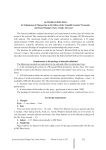Economic and Social Changes: Facts, Trends, Forecast @volnc-esc-en
Статьи журнала - Economic and Social Changes: Facts, Trends, Forecast
Все статьи: 1728
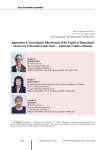
Статья научная
The export of education in Russia was officially proclaimed as a priority area of governmental policy in 2017. The subsequently adopted documents such as the project “Development of the export potential of the Russian education system”, the program “Priority 2030”, and the national project “Science and universities” confirm that the export of education remains an important governmental strategy, despite the changed geopolitical context. The export of education is considered in the works of scientists from Russia and other countries: they study in detail the economics of education export in various countries, adaptation of foreign students, methodological approaches, legal and visa systems of educational migration, etc. The aim of our work is to develop a methodology for evaluating the effectiveness of the export of education by universities in the cities - university centers of Russia and test it on the materials of the Siberian Federal District. Despite a wide range of relevant publications that we arranged in six main groups, these aspects have not been the subject of scientific analysis. We have developed our own system of indicators and indices (a comprehensive indicator of the effectiveness of the export activities of universities in the cities - university centers, calculated on the basis of indices of the educational and research potential of universities’ export activity). The methodology has been tested on the indicators for 115 universities and 30 cities - university centers of the Siberian Federal District. We have revealed that the data are scattered: out of 29 cities where foreign students study, only Tomsk is in the group of cities with high potential for educational and research export activities. The majority of the cities - university centers (22) belong to group 3 - with low potential for educational and research export activities. Our research makes it possible to comprehensively assess the effectiveness of the export of educational services by universities and cities - university centers in each group and set out the priorities for the development of universities; and also identify cities that best meet the needs of the country to implement the export of education.
Бесплатно
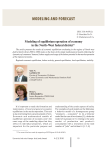
Approaches to assessment of energy security in the region (by the example of the Chelyabinsk oblast)
Статья научная
The article presents the results of analysis of key aspects of economic activity in the Chelyabinsk oblast by the example of assessment of energy security in the region. The article shows its dependence on individual elements of the fuel and energy complex. The authors calculated indicators of energy security and identified possible solutions of problems related to the potential threat to energy security in the region.
Бесплатно
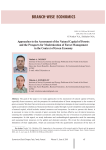
Статья научная
The goal of the paper is to study approaches to the assessment of natural capital of forests, especially forest resources, and the prospects for modernization of forest management in the context of green economy. We show that current socio-economic development strategies in most countries encourage rapid accumulation of physical, financial and human capital through excessive depletion and degradation of natural capital, which includes natural resources and ecosystems. In order to prevent this threat, it is necessary to move to the concept of green economy that involves effective use of natural resources, ensuring the sustainability of natural ecosystems and reducing the use of resources in production and consumption. In this regard, we study indicators and methodological approaches used for measuring and assessing forest resources in the global and domestic practice. We reveal the shortcomings and limitations of their application, which are associated with the quantitative assessment of the state of forests, without taking into account qualitative and structural changes...
Бесплатно
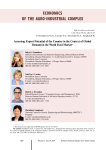
Assessing export potential of the country in the context of global demand in the world food market
Статья
Бесплатно
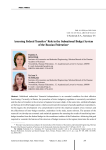
Assessing federal transfers' role in the subnational budget system of the Russian Federation
Статья научная
Subfederal authorities' financial independence is an essential condition for their effective functioning. Currently, in Russia, the procedure of inter-budgetary regulation is excessively centralized, and the share of transfers in the structure of regional revenues is high. At the same time, subfederal budgets arethebasiclevelofthebudgetsystem, whichconcentratesthemainpartofsociallysignificantexpenditures. In this regard, the development of a comprehensive tool for the empirical analysis of tax revenues and the effectiveness of inter-budget transfers, undertaken in the study, seems relevant. The purpose of the research is to develop an economic and statistical apparatus for assessing the results of transferring inter-budget transfers from the federal budget to the constituent entities of the Federation. Achieving this goal required to: consider the features of the structure of budget revenues in the regions; determine the scale of the territories' budget revenues heterogeneity, and give its quantitative assessment; identify the directions of the federal center's transfer policy; find out the nature of gratuitous transfers impact on the regional budgets. The novelty of the presented work is the creation of an economic and statistical apparatus for the study of the impact of federal budget policy on the region's public finance. This allowed us to characterize gratuitous transfers from the federal budget to the regions and determine whether there is a motivation to increase tax revenues in the Russian Federation's subjects or not. It is concluded that improving inter-budgetary relations should include measures to strengthen the Russian regions' tax potential, which is impossible if the stability of securing tax revenues is not ensured. Authorities need measures to prevent a direct correlation between actual and projected budget revenues and expenditures and the volume of transfers received from the federal budget to equalize budget security. The results of the research can be used to study the possibilities of improving budget policy in the direction of equalizing and stimulating the regions to strengthen their own revenue base.
Бесплатно
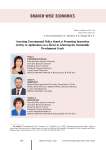
Статья научная
In the context of new global challenges and fulfillment of commitments to implement the Sustainable Development Agenda for the period up to 2030, it becomes especially relevant to assess the effectiveness of the current innovation policy pursued by the Russian Federation and its compliance with the priorities of sustainable development adopted by the international community. The purpose of the study is to assess the results of state policy aimed at enhancing innovation in the agricultural sector and to determine the extent to which the targets of programs and strategies for the development of agribusiness in the innovation sector comply with the priorities of Agenda 2030. Applying the system approach to the study of the concept for sustainable development and using our own integrated methodology, we have found that there are no significant results regarding the implementation of innovation policy; we have also revealed an extremely low degree of consistency of federal and regional sectoral programs with the priorities of the Sustainable Development Goals. We have determined that at present it is difficult to conduct a quantitative assessment of the results of innovation policy implementation at the level of a particular region, industry or company; the available indicators do not help to assess their contribution to the achievement of innovation-oriented Sustainable Development Goals. In this regard, we propose to include the objectives of the Sustainable Development Goals in state, sectoral and regional programs for scientific and technological development and to develop a system of their indicators, consistent with the targets of the documents on strategic development of agribusiness in the innovation sector, for monitoring purposes. Thus, the scientific novelty of the research lies in the development and implementation of our own approach to identifying the degree of compliance of the targets of current programs for development of the agricultural sector with the priorities of innovation-oriented Sustainable Development Goals. The results of this study can be used by executive authorities in the development and substantiation of correcting measures aimed at improving state policy in the field of promotion of innovation in the agricultural sector and, as a result, achieving the Sustainable Development Goals.
Бесплатно
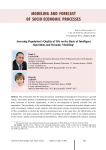
Assessing population's quality of life on the basis of intelligent algorithms and dynamic modeling
Статья научная
The article deals with the issues of research, modeling and management of society as a societal system. The authors propose a methodology for studying society based on the system composition of the main structures of activities organization, as well as the integration of general scientific laws and approaches. The peculiarity of the methodology is that society is represented as system integrity and a unity of economic, political, social, spiritual, and cultural sub-systems. Improving population’s quality of life is considered a criterion for society’s development and, at the same time, the effectiveness of its management. The paper proposes the models for assessing the quality of life as an integral indicator of the society’s quality of functioning and development, which allow evaluating this indicator, studying its structure, and the dynamics of its changes. An algorithm for managing the functioning quality of the societal system, based on the assessment of the integral index, is developed. A special feature of the algorithm is the complex application of data mining and dynamic modeling methods. The algorithm includes two main stages. At the first stage, data mining is performed on the quality of the system functioning in the selected area in the regional context. The results of the analysis allow identifying the clusters of regions and determining their characteristic features. The second stage involves developing the integral index structure and a dynamic model for assessing the functioning quality of the societal system on the basis of the integral index calculation, producing control actions in the form of changes in the volume of investments taking into account the characteristics of the constructed clusters. The authors consider the case of the developed algorithm implementation for quality management of social infrastructure in the regions of the Russian Federation, which allowed determining the recommended change in the level of investment in social infrastructure development by the regional clusters.
Бесплатно
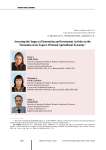
Статья научная
The issue concerning the formation of an export-oriented agricultural economy is associated with the need to assess its innovation and investment activity and analyze the quality of state policy to stimulate innovation and high technology products in agricultural production. High differentiation of Russian regions by natural and climatic conditions and the level of resource provision are factors that hinder the formation of new export positions, which predetermines the need to improve state investment policy, considering regional differences. The purpose of this study is to identify the dependence of the export level of agricultural products on the level of innovation and investment activity, the development of recommendations to improve innovation and investment activity of territorial and sectoral agricultural systems. We put forward the following hypothesis: one of the most important factors in increasing the volume of agricultural products exports of the region is the level of innovation and investment activity. As a methodological basis we use theoretical approaches of foreign and Russian authors to assessing the impact of innovation and investment processes on the increase of export potential, as well as the formation of balanced export-oriented agricultural systems in the territorial and sectoral sections. We develop a model estimating the relationship between investment in fixed capital in agriculture, gross output of the industry, and exports of agricultural products using methods of multivariate statistical analysis. We assessed the dynamics of regional innovation and investment development and compared the selected typological groups of Russian regions by their production and export efficiency, the resources used and the results achieved. The novelty and significance of the developed model lies in the possibility of its application for diagnostics and monitoring of the state of territorial sectoral and regional innovation and investment agrosystems. For each type of region we proposed differentiated strategies of state regulation aimed at overcoming the limitations of low innovation and investment activity in the formation of exportoriented agricultural economy. The results of the study are of practical value for the development and implementation of targeted mechanisms and tools to improve the efficiency of innovation and investment activities in order to ensure the leading position of the regions in exports of agricultural products.
Бесплатно
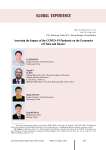
Assessing the Impact of the COVID-19 Pandemic on the Economies of China and Russia
Статья научная
The COVID-19 pandemic has significantly affected economic development in countries around the world. It aggravated existing problems and increased the demand for economic transformation, modernization and qualitative development, triggered a new technological reform, which led to the emergence of new economic business forms and new consumption. The article assesses the impact of the COVID-19 pandemic on the economies of China and Russia. To achieve this goal, we review the state of business activity in the manufacturing and non-manufacturing sectors of the national economy, and summarize the main measures of the anti-pandemic policy implemented by the Chinese and Russian governments. We look into the dynamics of functioning of offline economic spheres that are aimed at personal communication (tourism, catering, retail, transport, culture, entertainment), as well as online spheres implying human-computer interaction (electronic retailing, express delivery, remote work, telemedicine) in the context of the COVID-19 pandemic. We make conclude that the extent of COVID-19 impact on the economy depends on the effectiveness of measures for its prevention and control. We are convinced that at the moment it is necessary to correlate these measures with economic and social development policies, and take into consideration increased consumption as an important aspect of mitigating the effects of COVID-19, accelerate the transformation and modernization of traditional industries, actively develop new economic business forms and build a more open monetary circulation both within the country and globally, thus enhancing the role of the state in global supply chains.
Бесплатно
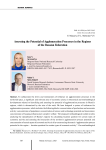
Assessing the Potential of Agglomeration Processes in the Regions of the Russian Federation
Статья научная
To substantiate the levers and mechanisms of influence on agglomeration processes in the territorial space, a significant and relevant area of economic science is theoretical and methodological developments related to identifying and assessing the potential of agglomeration processes in Russia's regions, which is determined by the aim of the work. We have designed a system of indicators for agglomeration processes, which includes the following blocks: concentration of production and economic activity; concentration of population; concentration of science and technology potential and innovations; concentration of housing infrastructure; people's welfare. The proposed methodological toolkit involves analyzing the specialization of Russia's regions by calculating location quotient for certain types of economic activity and assessing the interaction of the territory's agglomeration process potential and concentration of certain types of economic activity in it by constructing the matrix “agglomeration process potential in the region - location quotient for certain types of economic activity”. Our methodological approach was tested on 85 constituent entities of the Russian Federation. The research period included the years 2000, 2008, 2016-2022. The information base comprised data from the Federal State Statistics Service. According to the results of the calculations, we see a high degree of differentiation of agglomeration processes potential in the Central and Northwestern federal districts. Intensive agglomeration processes are observed in the Kaliningrad, Leningrad, Rostov, Nizhny Novgorod, Sverdlovsk, Tyumen, Novosibirsk regions, Krasnodar and Krasnoyarsk territories, the city of Sevastopol and the Republic of Tatarstan. There is a low potential for agglomeration development in the North Caucasus and the Far East, and in some years there were no agglomeration processes in the Chechen Republic and the Republic of Ingushetia. The findings of our research can be used by regional authorities in designing strategic planning documents, by a wide range of researchers in the field of spatial economics, and by teachers and students in the framework of personnel training in economic specialties
Бесплатно
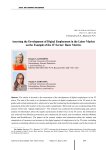
Статья научная
The article is devoted to the assessment of the development of digital employment in the IT sector. The aim of the study is to determine the metrics of digital employment in the IT sector in the gender and territorial perspective, which can be used for monitoring the development and comprehensive assessment of the labor market in the area under consideration. We provide our own understanding of the essence of the term “digital employment”. The research was conducted by benchmarking and content analysis of information about the supply and demand of labor force in the IT sector; the information was retrieved from Russian government and commercial job search and recruitment websites (Rabota Rossii and HeadHunter). The subject of the content analysis was information about the number and composition of vacancies and resumes in the digital segment of employment in the IT sector, including vacancies containing references to remote working hours, both overall in the sample, and in the context of gender and industry. The content analysis covered vacancies and resumes in all federal districts: Central, Northwestern, Southern, North Caucasian, Volga, Ural, Siberian and Far Eastern. The results were used to calculate the structure of professional qualifications, to identify gender specifics and general trends in the development of digital employment in the IT sector, both on average in the country and in the federal districts. The analysis of information on the demands of the labor market participants in the area under consideration allowed us to conclude about the asymmetry of supply and demand. In order to assess the development of the market for professional qualifications in the IT sector, the metrics of digital employment were identified, which help to evaluate its quantitative and qualitative characteristics, including in the gender and territorial perspective. The research results can further be used in monitoring the development and comprehensive assessment of digital employment in the IT sector, and also serve as the basis for the development and implementation of state policy programs to regulate digital employment in the labor market of the IT sector.
Бесплатно
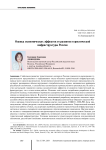
Assessing the economic effects of tourism infrastructure development in Russia
Статья научная
Consistent development of the tourism sector in Russia requires expanding tourist supply and increasing the number of tourist infrastructure facilities, primarily accommodation facilities. A significant increase in tourist supply promotes the expansion of domestic consumer demand, which is a driver of the Russian economy, and spurs industrial production. Thus, the assessment of the economic effects of tourism infrastructure development, which is the aim of the work, is becoming relevant. Addressing this problem requires working out a methodological approach that allows us to conduct scenario modeling as a result of changes in demand for tourism products. Methodologically, the study uses input-output tables, including our own approach to determining the volume of domestic tourism in Russia. Information base is formed by data from Rosstat and statistics agencies of other countries, EMISS, VEB.RF, databases of intermediate tables of resources and use of the Russian economy. Theoretical basis includes research works on the development of the tourism infrastructure and methods of its assessment, scenario modeling and forecasting of the economy. Scientific novelty consists in improving the tools for using input-output tables to analyze and evaluate the economic effects resulting from the development of new tourism infrastructure projects. The importance of the tourism industry for the Russian economy is clarified, and the change in economic indicators (output of goods and services, number of employees, wage fund by industry) is calculated as a result of the forecast growth in demand for hotel sector services. The obtained values confirm the importance of an active policy on import substitution of tourism to promote positive economic dynamics and indicate the need to ensure that the number of workers in the industry is sufficient. At the same time, the implementation of planned indicators for the development of tourism in Russia requires addressing several problems in the ways that are proposed in the conclusion.
Бесплатно
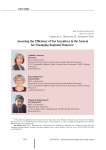
Assessing the efficiency of tax incentives in the system for managing regional finances
Статья научная
The paper analyzes existing techniques for assessing the effectiveness of tax incentives in the system for managing regional finances and reveals their advantages and disadvantages. It points out major conditions that determine the effectiveness of tax incentives at the regional level. The authors prove that assessing the effectiveness of tax incentives should focus, first, on identifying the relationship between the amounts of falling-out incomes and real economic benefits to the state and taxpayers that they entail; second, on determining the degree of correlation for this relationship; third, on adopting the decisions proceeding from the analysis of decisions concerning the extension of the incentive and its adjustment or possible abolition. The paper substantiates the conclusion that the effectiveness of tax incentives should be evaluated on the basis of three criteria: fiscal, economic and social. At that, the effectiveness of tax incentives at the regional level should be analyzed in several stages: calculation of budgetary, economic and social efficiency ratios; definition of the integral coefficient reflecting the total assessment of tax incentives efficiency; adoption of the decision about the appropriateness of introducing or further using the incentive, the decision being based on the calculations carried out previously...
Бесплатно
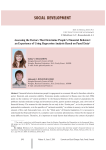
Статья научная
Financial behavior determines people’s engagement in economic life and is therefore critical to social, financial, and economic stability. Numerous studies conducted in Russia since the mid-1990s point out the existence of “system problems” in the financial behavior of the country’s population; the problems include moderate savings and investment activity, passive pension strategies, and a low level of financial literacy. The reasons for this situation lie not only in the “Soviet past”, or in the prevalence of paternalistic sentiments, or in the specifics of “national mentality” in relation to money, or in the limited amount of free cash that people have, or in the “blind spots” of financial legislation. It is necessary to understand that financial behavior is a complex socio-economic phenomenon, formed by the impact of many different factors. Therefore, it is important to study factors that influence the content of people’s financial behavior. The goal of the paper is to identify macroeconomic factors in people’s financial behavior; the factors that can be taken into account in the regulation of the financial sector and the social sphere...
Бесплатно
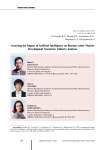
Статья научная
Artificial intelligence has become an essential element of technological progress, while generative artificial intelligence occupies a special place as an innovative general-purpose technology. Given the rapid development of this technology and its high potential for mass adoption in various economic sectors, it becomes important to assess the impact of this technology on the labor market. The modern Russian labor market is characterized by low unemployment, staff shortages, and intersectoral imbalances. An urgent scientific task is to model scenarios for the development of the labor market in the context of sectors, taking into account the influence of generative artificial intelligence. The aim of the work is to assess the potential impact of the mass use of generative artificial intelligence on the labor market, due to changes in labor efficiency in some professions and industries, based on the analysis of statistical and expert data and economic and mathematical modeling of possible scenarios for the development of the labor market. Economic sectors were divided into three groups depending on the rate of change in personnel needs, based on the analysis of the Beveridge curve, which shows the dependence of the level of needs on the unemployment rate. Using existing statistical data and expert assessments, we determine the degree of influence of generative artificial intelligence on labor efficiency in various industries. We put forward an approach that helps to obtain estimates of possible scenarios for the development of sectoral labor markets for the period up to 2030, based on official forecasts of ministries (Ministry of Economic Development of the Russian Federation, Ministry of Labor of the Russian Federation) for the period up to 2026, their extrapolation, and superimposition of the impact of mass use of generative artificial intelligence (as a disturbing effect). The results obtained suggest that the severity of staff shortage issue in general can be partially reduced by using generative artificial intelligence; thus, we identified industries in which (a) it is possible to address the problem of staff shortage at the current level of needs, and (b) staff shortage will persist. Modeling the migration of professions and personnel between industries seems promising, because the expected effect of mass technology adoption will not only change the balance of labor resources, but also lead to the need to re-profile some of the personnel.
Бесплатно
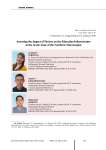
Статья научная
Given the orientation of Russia’s state policy toward the development of its Arctic zone, one of the major directions of socio-economic development in these territories is to modernize educational facilities and form a system of qualified personnel. Having calculated the rate of changes in the indicators, we reveal negative trends in the development of school and vocational education infrastructure in the Arctic zone of the Northern microregion; this confirms the relevance of the study. The education infrastructure, regarding its components, is understood as a set of infrastructure facilities of preschool, school and vocational education, as well as their staffing with qualified specialists. The aim of the research is to identify and assess the impact of a set of factors on the change in the education infrastructure in the Arctic zone of the Northern macroregion. We study the object of research at the mesoregional taxonomic level of spatial-territorial Arctic systems in relation to specific local communities; this increases the objectivity of our findings. The geography of the study is based on an institutional approach and includes Arctic mesoregions of the Arkhangelsk Oblast, Nenets Autonomous Okrug and the Komi Republic, which together form the Arctic zone of the Northern macroregion. We put forward our own methodological approach to assessing the impact of factors on social infrastructure in the Arctic zone of the Northern microregion. The approach contains a system of indicators reflecting changes in the education infrastructure and economic, demographic, spatial-territorial and socio-labor factors affecting it over the past fourteen years. We use methods of comparative analysis, systematization and grouping, statistical and correlation-regression analysis. The results of the study allow us to conclude that the influence of the factors on the education infrastructure in the Arctic zone of the Northern macroregion is differentiated depending on the nature and pace of development of the territories under consideration, state policy implemented in these territories, and other factors.
Бесплатно
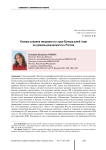
Assessing the impact of migration from Central Asian countries to birth rate in Russia
Статья научная
The current demographic crisis in Russia poses a challenge to the country’s socio-economic well-being. To handle the crisis, the government implements various demographic policy measures; some of them focus on migration as a way to maintain population stability. The largest share in Russia’s migration gain belongs to citizens from CIS countries. Most of them come from Central Asia, whose countries have a high birth rate. These trends suggest that newcomers start families in the Russian Federation, and migration contributes to the birth rate of the host country, which is estimated in the article. The contribution of migration from Central Asian countries to Russia’s birth rate is analyzed as an indicator reflecting the proportion of the number of births by women from Kyrgyzstan, Uzbekistan, Tajikistan, and Kazakhstan in the total number of births in Russia. The empirical base for the research includes three sources of statistical data reflecting an integrated approach to determining migration status: data on place of birth, citizenship and ethnicity. We find that 1.5% of children born in 2011-2023 in Russia are descendants of citizens of Central Asian countries; 0.5% of children born in Russia as of the critical moment of the 2020 census are descendants of Kyrgyz, Uzbeks and Tajiks; 11.1% of children have foreign-born parents (born outside the territory of the Russian Federation). Birth rate in foreign-born persons in Russia is also differentiated by federal districts. Subsequent research on this subject can focus on the dynamics of fertility in mixed families, and include statistics on RF constituent entities.
Бесплатно
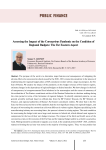
Статья научная
The purpose of the work is to determine major features and consequences of mitigating the adverse effects of a noneconomic shock caused by the 2020-2021 coronavirus pandemic in the process of implementing the regional budget policy of RF constituent entities within a large macroregion, the Far East of Russia. We analyze the impact of the pandemic on the budget revenues of Far Eastern regions, estimate changes in the dependence of regional budgets on federal transfers. We show changes in the level of transparency in intergovernmental fiscal relations in the macroregion and the extent of autonomy of the authorities of Far Eastern constituent entities of the Russian Federation in decision-making during the crisis period in terms of the formation of regional budgets. To identify statistical patterns, we use general scientific methods based on official data from the RF Federal Treasury, the RF Ministry of Finance, and regional authorities of Russia’s Far Eastern constituent entities. We show that in the Far East, the first and second waves of the epidemic had the most significant impact on regional budgets, and the pace of overcoming the coronavirus crisis was different in various regions. Regions specializing in the manufacturing industry are recovering faster; the process is slower in mining regions. The main condition for overcoming the budget crisis was a large-scale increase in federal aid, which allowed most regions to compensate for the loss of their own budget revenues. The impact of the third and fourth waves of the coronavirus crisis on the economy of the Far East and the regional budget sphere as a whole is assessed as weak. Mining industries continued to stagnate; as a result, in the analyzed period of 2020-2021, problems related to forming the tax base were noted in the majority of mining regions. Thus, we may predict that the state of regional budgets will depend more on the transfer support from the federal center. We reveal the absence of clear criteria in the provision of transfer support to the regions. Transparency of the aid provided to RF constituent entities has deteriorated during the pandemic crisis, which may lead to the emergence of adverse factors in regional development due to the desire of regional governments to lobby for special financial preferences from the federal center. The novelty of the research is due to the fact that we consider the aforementioned range of issues while comparing federal trends and the situation in the Far East under the increasing pressure of external noneconomic shocks caused by the lingering coronavirus pandemic. The materials of the article can be used in the educational sphere and in the work of state authorities at the federal and regional levels to improve budget policy.
Бесплатно
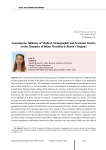
Статья научная
The issues of identifying and assessing the degree of influence of various factors on child mortality become particularly relevant in the light of the reduction in the proportion of children in the population and the decline in the birth rate. The quantitative assessment of the contribution of specific factors to the risk of child mortality is a key prerequisite for the substantiation of management measures aimed at minimizing it. Despite ample evidence of the influence of economic, medical and demographic factors on people’s health, there is a shortage of works devoted to the identification of quantitative correlations of these parameters with infant mortality in the context of Russian regions and the substantiation of approaches to the application of these tools in the practice of improving the child health care system. This study presents the results of assessing the relationship between a number of economic, demographic parameters and indicators of the provision with health care resources and infant mortality. Russia’s regions have been grouped according to the level of health care resources provision (bed fund, doctors, outpatient facilities), the characteristics of the leading regions have been analyzed. The correlation analysis revealed that the greatest correlation with the indicator of infant mortality of the regional population is demonstrated by age-specific birth rates in the youngest reproductive ages (15-19 years and 20-24 years), indicators of the provision of beds for pregnant women and children. Regression analysis of panel data for Russian regions revealed quantitative relationships between the infant mortality rate, age-specific birth rates, the value of gross regional product and the health care resources provision. The results of the study may be of interest to specialists in the field of regional child health care.
Бесплатно

